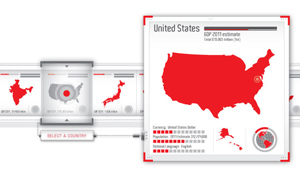News & Stories
Location. Location. Location.
Location has an impact on corporate income taxes.
During a 2008 presidential campaign debate, Sen. John McCain stated, “Right now, American business pays the second-highest business taxes in the world.”

Then-Sen. Barack Obama countered: “There are so many loopholes that have been written into the tax code … that we actually see our businesses pay effectively one of the lowest tax rates in the world.”
As he watched the debate, accounting professor Doug Shackelford wasn’t sure who was right.
Shackelford has spent his career studying international taxation, and he knew where he could find the answer: a new database that UNC Kenan-Flagler had just purchased provided computer-readable financial statements for thousands of firms from 83 countries around the world.
Twenty years ago, Shackelford compared the effective tax rates (ETRs) of the U.S, U.K. and Canada, the only countries from which data was available then. No other researcher has done anything similar since.
“Because the data had to be hand-collected, we had not been able to compare ETRs across all these different countries,” Shackelford said. “McCain and Obama had very little evidence to base their claims on. We’re trying to fill that void.”
To provide empirical underpinnings for the ongoing debates of international tax competition, Shackelford and Kevin S. Markle (PhD ’10) of the University of Iowa mined the database. They compared corporate ETRs for companies in 83 countries over the past 20 years. They used regression equations to compare tax rates of multinational (MNC) and domestic firms across countries and to determine if MNCs and domestics in the same country face different tax rates.
The result is the most comprehensive analysis of firm-level corporate income taxes to date. Their paper “Cross-Country Comparisons of Corporate Income Taxes” reports their findings along with data by country and group; comparisons of cash, current and total ETRs; and breakdowns of tax expenses by year and industry.
Where businesses locate is central to debates about the taxation of MNCs, and the researchers confirmed the importance of where a firm locates for tax purposes. They demonstrated that:
- The location of an MNC and its subsidiaries substantially affects its worldwide ETR.
- MNCs headquartered in the United States are among the highest-taxed.
- MNCs based in tax havens face the lowest taxes.
- ETRs around the world have fallen across the board over the past two decades, but the ordinal rank from high-tax countries to low-tax countries has changed little, despite radical changes in tax policy, financial reporting, economic development, laws and politics.
- There is little difference between the ETRs of multinationals and domestic-only firms.
These findings are useful for policymakers and corporate decision makers alike.
The question of whether the United States’ high-rate, low-base tax structure translates into high, low or average tax rates compared to other countries has long been debated. When countries compete for businesses, one tactic is to offer tax savings. A country can raise or lower its ETR by altering its tax rates or its tax base. Though the United States has not altered its rates, it has altered its base to reduce the total tax burden.
Other countries are lowering their tax burden faster than the United States, Shackelford said. However, the United States bests its competitors on many aspects that appeal to businesses, enabling it to offset possible tax disadvantages.
“The United States market far exceeds the rest of the world,” Shackelford said. “All the things that make for a huge customer market are in place: the best capital markets, the best transportation system, the most innovative researchers, the best universities – you can go down the list. If you’re a multinational, you have no option but to be in the United States, even if our corporate taxes are a bit higher than in most of the world.”
Their study also showed that tax rates vary tremendously from industry to industry in every country. In fact, their findings drew them into a political firestorm on the other side of the world. An Australian Treasury report cited figures from their paper to argue that miners were undertaxed. The ensuing debate contributed to the fall of the government and front-page coverage of their work.
In the long-standing debate over whether tax structures favor multinationals or small, independent businesses, Shackelford found no difference, on average, in a comparison of ETRs of multinationals with ETRs of companies located in only one country.
“That surprised both those who believe multinationals are treated unfairly compared with domestics and those who think that domestics are tax-disadvantaged,” he said.
Now Shackelford is delving into what causes these cross-country differences. By holding the tax rate constant, he can see variations in the tax base that might be driving the ETR. He’s studying three factors that play a role in a company’s tax burden:
- The amount of debt a company has (because interest is deductible)
- The extent to which a company is intangible-driven (relies on human capital more than brick-and-mortar assets)
- The extent to which a company locates in tax havens
He is testing each company, working his way through the list. So far, his research has found evidence for all three influencing ETR, but more work is forthcoming.
“What we have done is the best attempt to compare the effective tax rates of all publicly traded companies around the globe,” said Shackelford. Corporate leaders, politicians and policymakers now have an empirical underpinning for ongoing policy debates about the taxation of multinationals.
“We provide facts to what are, by and large, people just making assertions,” Shackelford said.
Key take-aways
- The location of a multinational and its subsidiaries substantially affects its worldwide effective tax rates (ETR).
- Multinationals based in tax havens face the lowest taxes; United States MNCs face among the highest.
- There is little difference between the ETRs of multinational and domestic-only firms.